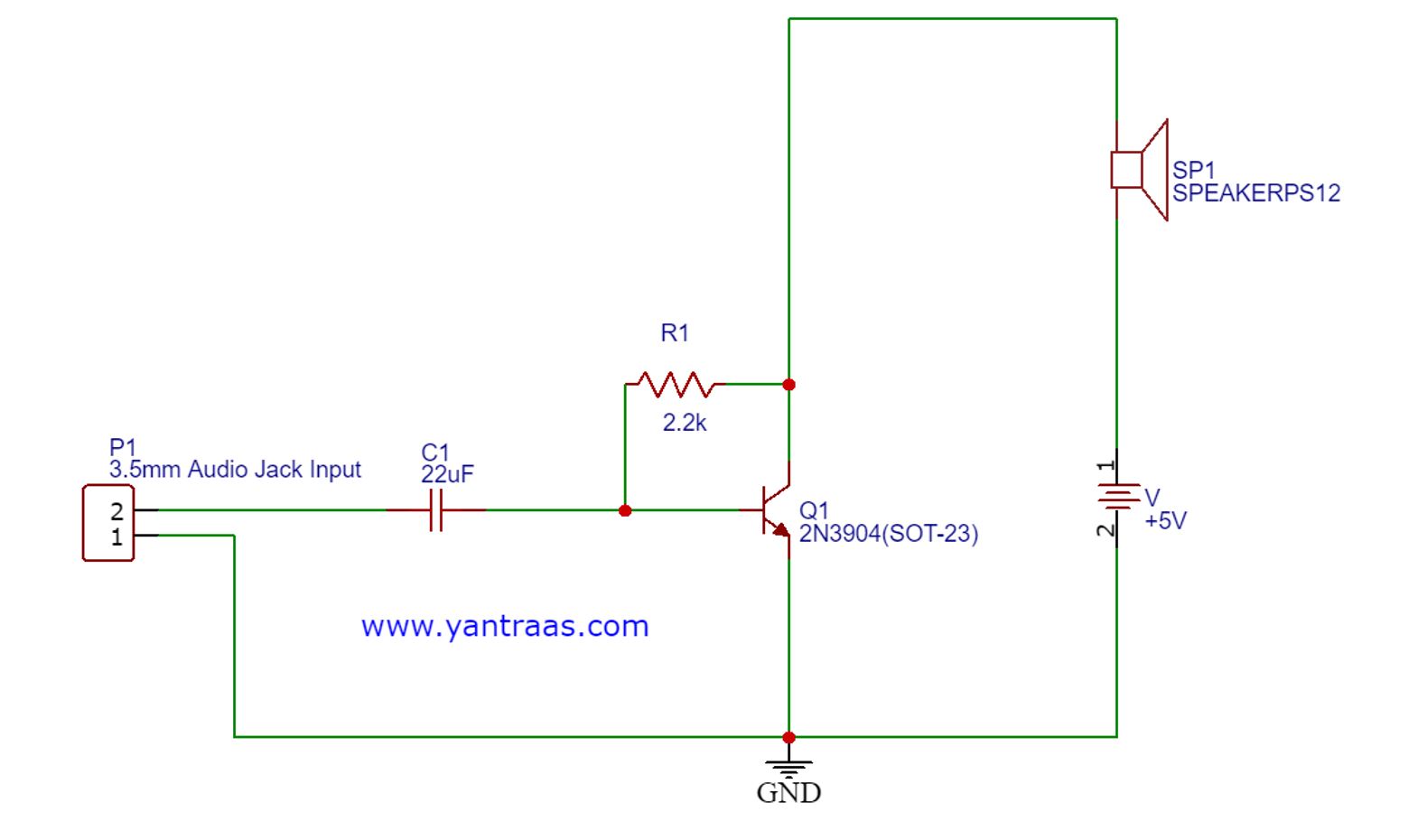Hey fellas! How’ve you been?
I hope you are doing good and staying safe out there.
Today I have an interesting project for y’all.
In this article let me teach you how to make a simple amplifier with a transistor.
It’s not difficult but it’s very appealing.
See for some reason when I first heard of the word amplifier in my high school, I immediately thought of a big speaker box.
Only later did I realize that amplifiers don’t just amplify sound. There are different classes to them and they amplify different physical entities to different degrees.
In the beginning, I wanted to shape this article around a voltage amplifier. But to make it more relatable to the masses I thought why not create this article as a guide on how to make a simple audio amplifier with a transistor.
Doing so will invite more attention to the topic because audio plays a big role in keeping almost every one of us entertained.
So, my reasoning is simple that if I teach you something that keeps you interested you will learn more.
I hope you agree or at least understand the reasoning behind the article.
Now without any further ado let’s get into it.
By the way, here are some more articles that I think will attract your inclination. They all open in a new tab.
- Do Arduino sensors work with raspberry pi?
- What is PWM and what is it role in practical electronics?
- How to control the speed of a DC motor?
- How to convert a monitor into a smart TV?
- How to stream video from raspberry pi to your phone?
Let us start with the very basic question that I am pretty sure you would have had prior to getting here.
What Is A Single Transistor Amplifier?
A single transistor amplifier is pretty much what it sounds.
If an amplifier circuit consists of just one amplifier that is responsible for amplifying a weak signal.
While a single-stage or a single transistor amplifier is widely used as a learning tool, most practical applications have multiple transistors connected in stages.
That does give a certain degree of complexity to the circuit for obvious reasons, but those complex circuits can be broken down into simple single-stage amplifiers and analyzed.
It will sound funny but the first time I heard what an amplifier was capable of doing, I thought what kind of sorcery is this?
How can something increase the power of a weak signal like that?
Only a little while later did I realize that the increase of power is a result of energy being taken from the power supply and the control of output to duplicate the input signal shape (but with larger amplitude of course).
So, don’t be embarrassed if you think a transistor is something magical.
In a way it is. And your world is ruled by it.
Matrix movie theme intensifies.
Can We Make Amplifier With Any Transistor?
Another very important question that needs to be addressed before we move any further.
And these are the types of questions that usually arise in the minds of people who have recently started learning practical electronics.
So, can you make an amplifier out of any transistor?
Well technically, every transistor in its entirety is basically an amplifier.
In an earlier segment of this post, I mentioned that I wanted to create this article around teaching you how to create a voltage amplifier.
So, transistors are entities that aid in the amplification of physical parameters like current, voltage, power, audio, etc.
The amplification process isn’t the result of independent action but because a transistor is capable of controlling large current at the output using a small signal in the input.
In simpler words, a transistor is capable of recreating the input signal in an amplified form using an external power source.
The two most commonly used types of transistors are BJTs and FETs.
A BJTs amplification factor or beta is the ratio of its collector current over its base current.
It doesn’t matter what kind of transistor you use it will ultimately act as an amplifier of signals.
Simple Amplifier Circuit Diagram Using Transistor
Alright with those basics out of the way it’s time to get into actually making a simple amplifier with a transistor.
The best way to create a framework of how you are going to proceed in electronics is a circuit diagram.
So, let me first share with you the circuit diagram that we are going to use to actually create an audio amplifier using a transistor.

How To Make A Simple Amplifier With Transistor?
Okay, so now that we have the basics and the circuit diagram in place let’s actually systematically create our audio amplifier with a transistor.
Here are the components that you are going to need.
- Transistor – Any NPN type – I am using 2N6292 x1
- Resistor– 2.2k or 4.7k x1
- Capacitor– 22uF x1
- 3.5 mm Jack x1
- Speaker x1
- Breadboard x1
Once you have all the necessary components follow these steps to create an audio amplifier for yourselves.
It really is as simple as seeing the circuit diagram and placing the relevant components in tandem with each other and supplying power.
However, as I know many beginners will be seeing this article.
Here is how you proceed.
- Remember the outermost line of the breadboard out of convenience and convention is treated as power and the line next to it is ground.
- First of all, place the resistor on the breadboard.
- Now put the 2.2k ohm resistor between pin 1 and 2 of the transistor. Loosely said short the pin 1 and 2 of the transistor using a 2.2k ohm resistor.
- Now place the positive end of the capacitor such that it connects to pin 1 of the transistor.
- The negative end of the same capacitor connects to one end of the 3.5mm jack.
- The other end of the 3.5mm jack connects to the ground of pin 3 of the transistor.
- Now let’s connect the speaker. Connect one end of the speaker to pin 2 of the transistor as shown in the circuit diagram.
- The other end of speaker gets connected to the positive side of the 5 V battery.
- Lastly, connect the negative end of the power supply to pin 3 of the transistor thus creating a common ground.
That’s it. Al that is left for you is to connect the 3.5 mm jack to an audio output of your favorite device and enjoy the amplified audio.
You can even try and create a permanent circuit on a PCB and use it as a podcast player.
It’s up to you how you want to use it.
Which Transistors Are Best for Amplifier?
So, that is how you make a simple amplifier with a transistor.
If you are a beginner or someone getting started with practical electronics, I think this project can act as a great starting point.
Another very important question that I think makes sense to address here is which transistors apart from what we have used here are good for amplifier projects.
So as far as applications of transistors for audio amplification is concerned there are many different types of BJTs that you can consider.
That being said you need to also be mindful of the fact that, it will be the overall circuit and not just the transistor that will make the circuit of an audio amplifier work well.
Two of my favorite picks when it comes to transistors for audio amplification are,
- 2N4401(NPN) and,
- 2N4403(PNP)
I have used these two transistors in many projects over the years.
They have decent gain and can handle voltages in the range of ~40 V which should be good enough for most practical projects.
Once again what needs to be highlighted yet again here is that it really isn’t about transistors, to be honest.
You can create great audio amplifiers using these transistors and you may also not have the results you want if the overall circuit isn’t paid enough attention in the planning stage.
And for that reason, at the beginning of this article, I highlighted the importance of having your basics right.
And you are obviously not limited to having BJTs as your transistors of choice. You can also go with JFETs and MOSFETs.
Once again deploying these will require having a good understanding of how to create a complementing circuit that lets you take advantage of them properly.
If you are a beginner I would recommend you to stick with BJTs and once you are well versed take the plunge into more advanced circuits that use JFETs and MOSFETs.
FAQs
I hope you enjoyed creating your transistor-based amplifier and if you did I hope you deploy it to good use.
While I can safely say that I have covered all essential basics and surrounding topics to help accomplish the project, I understand that knowledge is always limited.
Therefore, in this small questionnaire, I am trying to cover some more queries that will provide even more clarity.
If you have any more questions just let me know in the comments section below.
If the query is potent and helps a wide domain of users I will include the questions in this section.
Can MOSFETs Be Used As Amplifiers?
Yes, MOSFETs can definitely be used as linear amplifiers. However, unlike junction transistors MOSFETs being current-controlled devices are deployed primarily as switching units rather than conventional linear amplifiers.
What Is The Difference Between NPN and PNP Transistors?
Structurally, an NPN transistor has a layer of p-type silicon between two n-type layers. It’s the reverse in PNP transistors. NPN transistors find application primarily in switching and amplification. PNP transistors on the other hand find use in Darlington pair circuits and to control current flow in heavy applications like robotics.
How Transistors Work As Switches?
Acting as a switch in an electronic circuit is one of the most important uses a transistor can be subjected to. A transistor allows current flow across the collector-emitter with voltage applied to the base. Consequently, when no base voltage is applied the switch is OFF, and when the base voltage is present the switch is ON.
I hope you enjoyed reading and learning from this article on how to make a simple amplifier with transistor.
Now I know despite my best efforts there may be some points that I may have failed to cover regarding the core topic or supporting topics around it.
If you have any other queries, comments, or feedback regarding anything that you have read here do let me know in the comments section below.
Take care of yourselves and I will see you in the next one!
Tada!



